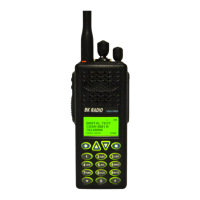KNG Portable Radio User’s Manual
- 17 -
Code Guard Operation
Code Guard Receive
Analog channels programmed with a receive code guard will be heard
only when the proper frequency and Code Guard value is received.
Analog and mixed mode receive channels will also unmute when the
radio is in monitor mode.
Code Guard Transmit
Whenever transmitting on an analog channel, any programmed sub-
audible Code Guard is transmitted. Depending on radio programming,
the Code Guard can be the default tone assigned to the channel or a
tone selected from the Code Guard Picklist (see Pick List Options).
15
1
2
3
4
5
6
7
8
9
11
10
12
13
14
16
SCAN
PRI
VOL
Busy Channel/Transmit
Indicator
The frequency must be clear prior to
transmitting on a Code Guarded channel. If the
LED Indicator is yellow do not transmit. Busy
Channel Lockout can be programmed to
disallow transmitting while a channel is busy.
1. Press the PTT switch. When the transmitter
is on, the LED Indicator glows red and TX
appears in the display.
2 Talk in a normal voice with the microphone
one to two inches from your mouth.
3. Release the PTT switch to stop transmitting.
Analog Squelch Control
Sub-audible signaling (CTCSS/CDCSS) is used to allow a group of
radios to be selectively called in an analog system. Programming the
receive code guard equal to zero allows for Carrier Squelch operation,
where the radio will unmute whenever a carrier is detected regardless
of the transmitted Code Guard.
APCO Project 25 Digital Squelch Control
Network Access Codes (NACs) provide the digital equivalent of analog
sub-audible signaling (CTCSS/CDCSS) allowing a group of radios to be
selectively called within a system.
Users in the same area (using the same NAC) can be further divided

